As energy costs and global food shortages continue to rise, governments and water associations focus on irrigation infrastructure projects that can deliver irrigation water with cost-efficiency. Irrigation water supply projects can broadly be divided into three key areas:
- Pumping Station and Water Source Management
- Water Distribution Network
- Smart Hydrants – infield control heads
- What is the functionality of surge anticipating valves (735) as part of a surge protection solution? Why is it installed offline using several units?
Pressure surge is likely to happen in hydraulic systems whenever a fluid in motion is forced to stop or change velocity suddenly, and "suddenly" is the keyword here, if it happens too fast that’s when pressure surge starts to develop.
The most common emergency scenario that could occur, is a pump trip due to power failure. This happens mainly when there are pumps that deliver water through uphill lines, also called rising mains. To prevent the damage that might be caused due to pressure surges, hydraulic system designers must consider and implement surge protection solutions.
A possible solution is based on releasing the excessive energy in the network, created by the development of a pressure wave, back to the atmosphere using a hydraulic control valve - in this case Surge Anticipating Valve (SAV).
of a pressure wave, back to the atmosphere using a hydraulic control valve - in this case Surge Anticipating Valve (SAV).
The Surge Anticipating Valve is an off-line (branched), hydraulically operated control valve. It is equipped with two pilots, a low-pressure pilot and a high-pressure pilot which sense the main line pressure. The valve opens in response to the pressure drop associated with abrupt pump stoppage. The pre-opened valve dissipates the returning high-pressure wave, eliminating the surge. The valve smoothly closes drip tight as quickly as the relief feature allows, preventing a closing surge. The valve can also relieve excessive system pressure.
The surge anticipating valve treats only the positive surge therefore a mandatory part of this solution is using Combination Air Valves that deal with the negative surge, by admitting air into the pipelines preventing vacuum conditions and pipe collapse. The Combination Air Valves ensure controlled and safe air relief when the positive wave returns towards the pumping station.
There are several advantages to install more than one Surge Anticipating Valve offline:
- One of the units can be used as a quick relief valve (QRV) , relieving any excessive line pressure
- Redundancy - allowing maintenance on one valve while the irrigation system is still operating properly
- Gradual opening of the valves during a surge event without enhancing the surge phenomena
- Gradual closing of the valves after the surge dissipates, preventing secondary surge due to quick valve closure
- Reducing the size of valves to allow easier maintenance
<< Click here for more information on BERMAD Surge Anticipating Valve >>
- What is the importance of installing combination air valves along the irrigation system and why is it recommended to install an air valve upstream to a water meter?
The presence of uncontrolled quantities of air in water systems can seriously affect their performance, causing inefficient filling and draining procedures and flow reduction, while increasing energy costs. It also disrupts the proper functioning of some system components, such as pumps, sensors, water meters, hydraulic control valves and more.
On the other hand, air is essential in dealing with vacuum conditions and pressure surges. Air control in pressurized water systems is critical for increasing efficiency during filling, draining and pressurized operation, as well as to protect them from vacuum conditions and pressure surges.
In the previous answer, we explained that Combination Air Valves deal with the negative surge, by admitting air through the kinetic orifice into the pipelines preventing vacuum conditions and pipe collapse. This also applies to burst and drainage scenarios in which air valves admit air into the pipeline, preventing vacuum conditions.
In scenarios of pipeline fill up the combination air valves allow to expel the air from the pipelines, through the kinetic orifice, ensuring efficient line fill-up.
During pressurized operation, the Combination Air Valves ensure efficient operation by expelling air bubbles through the automatic orifice, preventing air pockets accumulation that can dramatically reduce the flow. Expelling air bubbles during pressurized operation is crucial for the proper operation of system components such as water meters. Therefore, it is highly recommended to install a combination air valve on the upstream of water meters to ensure reading accuracy and full pipe.

BERMAD recommends installing a surge protection feature (SP) for all air valves in the hydraulic system, especially on critical points like the pumping station.
When the column of water and air approaches with high flow velocity (during surge or uncontrolled line fill up) it might push up the float quickly and violently, resulting in slam and secondary surge, damaging the air valve and the system components. The SP feature which is a disc with small holes prevents this slam, allowing controlled air relief without a secondary surge.
<< Click here for more information on BERMAD Air Valves >>
- What is the purpose of adding a pressure-sustaining feature to BERMAD Pump Control Valve?
BERMAD Pump control valve also called Active Check Valve is a hydraulically operated control valve installed on the discharge line of the pump.
It's a solenoid-operated valve that opens fully or shuts off in response to electric signal, isolating the pump from the system during pump startup and shutdown, thereby preventing pipeline surges and protecting the system from pressure shocks during daily operation.
The pump control valve also acts as an excellent mechanical check valve that closes surge-free before the column of water changes direction protecting the pumps from reverse flow.
Regulation features can be added to this valve. Adding a Pressure Sustaining feature means that while the valve is open it sustains the minimum required pump discharge pressure, regardless of fluctuating flow, and prevents the pump from exceeding its designed flow or power consumption. In fact, the pressure-sustaining feature maintains the pump in the efficiency zone of the pump curve, protecting it from cavitation conditions and damage, as well as electrical overload due to overconsumption scenarios (e.g. high flow, low pressure).
<< Click here for more information on BERMAD pump control and pressure sustaining Valves >>
If you missed the webinar and would like to learn more about advanced technologies for delivering irrigation water efficiently, take a look at the webinar recording here.
- Is the Omega controller suitable to support fertilization programs including fertmeters (proportional and volume)?

Yes, the Omega cloud-based irrigation controller supports fertilization programs, both based on time and volume.
<< Click here for more information on Omega Controller >>
- What's the largest diameter of BERMAD's hydraulic control valve?
The BERMAD 700 Series Large Size Control Valves are hydraulically operated, diaphragm actuated type. Unique hydro-dynamic globe valve design with a special open plug provides high flow capabilities. The largest of these valves is 700-M5L 36 inch/DN900.
<< Click here for more information on BERMAD Large Control Valves >>
- As part of an engineering company involved in large-scale irrigation projects, for example currently involved in a 10,000 Ha project in which farmers cultivate mainly tomatoes. At what stage of the project should we consult BERMAD? And where can we get more data about BERMAD's solutions and supporting tools?
We in BERMAD highly recommend and urge you to approach us as early as possible in the stage of project prescription and design, to ensure the ability to implement efficient, advanced and smart solutions that can increase system performance, life span, yield, reduce energy consumption as well as coping with unique project requirements.
Find more data about BERMAD solutions and supporting design tools is in the Irrigation Infrastructure brochure.













